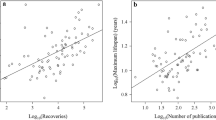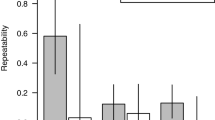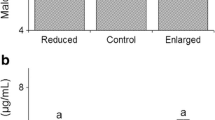Abstract
Antioxidants have a large potential to coevolve with life-histories because of their capacity to counteract the negative effects of free radicals on fitness. However, only a few studies have explored the association between antioxidant levels and life-history strategies comparing a large number of species. Here we used an extensive dataset of 125 species of birds to investigate the association between concentrations of antioxidants (carotenoids and vitamin E) in the liver, which is the main storage organ for fat-soluble antioxidants, and life-history and morphology. We found that high liver antioxidant concentrations were associated with life-history strategies characterized by “live slow, die old”, in clear contrast to previous studies reporting a relationship between high plasma antioxidants and life-histories characterized by “live fast, die young”. Thus, high carotenoid concentrations were present in species with large body, brain and egg sizes, high absolute metabolic rate and a resident lifestyle, while high vitamin E concentrations were present in species with large brain size and long life span and incubation period. Our results indicate that antioxidants and life-histories coevolve, and that this may be mediated by positive fitness consequences of the accumulation of liver antioxidants, as species with higher antioxidant levels live longer.

Similar content being viewed by others
References
Alonso-Alvarez C, Bertrand S, Devevey G, Prost J, Faivre B, Sorci G (2004) Increased susceptibility to oxidative stress as a proximate cost of reproduction. Ecol Lett 7:363–368
Alström P, Olsson U, Lei F, Wang H-T, Gao W, Sundberg P (2008) Phylogeny and classification of the Old World Emberizini (Aves, Passeriformes). Mol Phylogenet Evol 47:960–973
Antoniazza S, Burri R, Fumagalli L, Goudet J, Roulin A (2010) Local adaptation maintains clinal variation in melanin-based coloration of European barn owls (Tyto alba). Evolution 64:1944–1954
Barja G (2004) Aging in vertebrates, and the effect of caloric restriction: a mitochondrial free radical–DNA damage mechanism? Biol Rev 79:235–251
Barón V, Muriel P (1999) Role of glutathione, lipid peroxidation and antioxidants on acute bile-duct obstruction in the rat. Biochim Biophys Acta Gen Subj 1472:173–180
Biard C, Gil D, Karadaş F, Saino N, Spottiswoode CN, Surai PF, Møller AP (2009) Maternal effects mediated by antioxidants and the evolution of carotenoid-based signals in birds. Am Nat 174:696–708
Carrascal LM, Galván I, Gordo O (2009) Partial least squares regression as an alternative to current regression methods used in ecology. Oikos 118:681–690
Castenmiller JJM, West CE (1998) Bioavailability and bioconversion of carotenoids. Annu Rev Nutr 18:19–38
Cohen AA, McGraw KJ, Wiersma P, Williams JB, Robinson WD, Robinson TR, Brawn JD, Ricklefs RE (2008) Interspecific associations between circulating antioxidant levels and life-history variation in birds. Am Nat 172:178–193
Cohen AA, Mauck RA, Wheelwright NT, Huntington CE, McGraw KJ (2009a) Complexity in relationships between antioxidants and individual life-history parameters in a seabird and a songbird. Oikos 118:1854–1861
Cohen AA, McGraw KJ, Robinson WD (2009b) Serum antioxidant levels in wild birds vary in relation to diet, season, life history strategy, and species. Oecologia 161:673–683
Costantini D, Møller AP (2008) Carotenoids are minor antioxidants for birds. Funct Ecol 22:367–370
Costantini D, Møller AP (2009) Dos immune response cause oxidative stress in birds? A meta-analysis. Comp Biochem Physiol A 153:339–344
Costantini D, Dell’Ariccia A, Lipp HP (2008) Long flights and age affect oxidative status of homing pigeons (Columba livia). J Exp Biol 211:377–381
Cramp S, Perrins CM (1993–1994) The birds of the western Palearctic, vols 7–9. Oxford University Press, Oxford
Cramp S, Simmons KEL (1977–1992) The birds of the western Palearctic, vols 1–6. Oxford University Press, Oxford
Cutler RG (1991) Antioxidants and aging. Am J Clin Nutr 53:373S–379S
Davis KE (2008) Reweaving the tapestry: a supertree of birds. Ph.D. Thesis. University of Glasgow, Glasgow, UK
del Hoyo J, Elliott A, Sargatal J (eds) (1992–2008) Handbook of the birds of the World. Lynx, Barcelona, Spain
del Val E, Senar JC, Garrido-Fernández J, Jarén M, Borràs A, Cabrera J, Negro JJ (2009a) The liver but not the skin is the site for conversion of a red carotenoid in a passerine bird. Naturwissenschaften 96:797–801
del Val E, Borràs A, Cabrera J, Senar JC (2009b) Plumage colour of male Common Crossbills Loxia curvirostra: visual assessment validated by colorimetry. Rev Catalana d’Ornitologia 25:19–25
Díaz-Uriarte R, Garland T Jr (1996) Testing hypotheses of correlated evolution using phylogenetically independent contrasts: sensitivity to deviations from Brownian motion. Syst Biol 45:27–47
Diniz-Filho JAF, De Sant’ana CER, Bini LM (1998) An eigenvector method for estimating phylogenetic inertia. Evolution 52:1247–1262
Dowling DK, Simmons LW (2009) Reactive oxygen as universal constraints in life-history evolution. Proc R Soc B 276:1737–1745
Dunning JB (1993) Handbook of avian body masses. CRC Press, Boca Raton
Dvorska JE, Pappas AC, Karadaş F, Speake BK, Surai PF (2007) Protective effect of modified glocomannans and organic selenium against antioxidant depletion in the chicken liver due to T-2 toxin-contaminated feed consumption. Comp Biochem Physiol C 145:582–587
Felsenstein J (1985) Phylogenies and the comparative method. Am Nat 125:1–15
Finkel T, Holbrook NJ (2000) Oxidants, oxidative stress and the biology of ageing. Nature 408:239–247
Futuyma DJ, Moreno G (1988) The evolution of ecological specialization. Annu Rev Ecol Syst 19:207–233
Galván I, Alonso-Alvarez C (2009) The expression of melanin-based plumage is separately moduated by exogenous oxidative stress and a melanocortin. Proc R Soc B 276:3089–3097
Galván I, Gangoso L, Grande JM, Negro JJ, Rodríguez A, Figuerola J, Alonso-Alvarez C (2010) Antioxidant machinery differs between melanic and light nestlings of two polymorphic raptors. PLoS ONE 5:e13369
Galván I, Mousseau TA, Møller AP (2011) Bird population declines due to radiation exposure at Chernobyl are stronger in species with pheomelanin-based coloration. Oecologia 165:827–835
Garamszegi LZ, Eens M, Erritzøe J, Møller AP (2005) Sperm competition and sexually size dimorphic brains in birds. Proc R Soc B 272:159–166
Garratt M, Vasilaki A, Stockley P, McArdle F, Jackson M, Hurst JL (2011) Is oxidative stress a physiological cost of reproduction? An experimental test in house mice. Proc R Soc B 278:1098–1106
Ghalambor CK, Martin TE (2002) Comparative manipulation of predation risk in incubating birds reveals variability in the plasticity of responses. Behav Ecol 13:101–108
Goodwin TW (1950) Carotenoids and reproduction. Biol Rev 25:391–413
Grosso AR, Bastos-Silveira C, Coelho MM, Dias D (2006) Columba palumbus Cyt b-like Numt sequence: comparison with functional homologue and the use of universal primers. Folia Zool 55:131–144
Halliwell BH, Gutteridge JMC (2007) Free radicals in biology and medicine. Oxford University Press, Oxford
Hill GE (1996) Redness as a measure of the production cost of ornamental coloration. Ethol Ecol Evol 8:157–175
Hoffman DJ, Heinz GH (1998) Effects of mercury and selenium on glutathione metabolism and oxidative stress in mallard ducks. Environ Toxicol Chem 17:161–166
Hood GM (2010) PopTools version 3.2.3. Available at: http://www.poptools.org
Hõrak P, Cohen A (2010) How to measure oxidative stress in an ecological context: methodological and statistical issues. Funct Ecol 24:960–970
Hõrak P, Vellau H, Ots I, Møller AP (2002) Fat-soluble antioxidants in the eggs of great tits Parus major in relation to breeding habitat and laying sequence. Avian Sci 2:123–130
Isaksson C, Örnborg J, Stephensen E, Andersson S (2005) Plasma glutathione and carotenoid coloration as potential biomarkers of environmental stress in great tits. EcoHealth 2:138–146
Iwaniuk AN, Nelson JE (2003) Developmental differences are correlated with relative brain size in birds: a comparative analysis. Can J Zool 81:1913–1928
Jensen C, Lauridsen C, Bertelsen G (1998) Dietary vitamin E: quality and storage stability of pork and poultry. Trends Food Sci Technol 9:62–72
Julliard R, Clavel J, Devictor V, Jiguet F, Couvet D (2006) Spatial segregation of specialists and generalists in bird communities. Ecol Lett 9:1237–1244
Kodric-Brown A, Brown JH (1978) Influence of economics, interspecific competition, and sexual dimorphism on territoriality of migrant Rufous Hummingbirds. Ecology 59:285–296
Koutsos EA, Calvert CC, Klasing KC (2003) The effect of an acute phase response on tissue carotenoid levels of growing chickens (Gallus gallus domesticus). Comp Biochem Physiol A 135:635–646
Kurien BT, Scofield RH (2008) Autoimmunity and oxidatively modified autoantigens. Autoimmun Rev 7:567–573
Lasiewski RC, Dawson WR (1967) A re-examination of the relation between standard metabolic rate and body weight in birds. Condor 69:13–23
Latscha T (1990) Carotenoids: their nature and significance in animal feeds. F. Hoffmann-LaRoche Ltd, Basel
Martin TE (1995) Avian life history evolution in relation to nest sites, nest predation, and food. Ecol Monogr 65:101–127
Martin TE, Martin PR, Olson CR, Heidinger BJ, Fontaine JJ (2000) Parental care and clutch sizes in North and South American birds. Science 287:1482–1485
Martínez A, Rodríguez-Gironés MA, Barbosa A (2008) Donator aceptor map for carotenoids, melatonin and vitamins. J Phys Chem A 112:9037–9042
McCord JM (2000) The evolution of free radicals and oxidative stress. Am J Med 108:652–659
McGraw KJ, Wakamatsu K (2004) Melanin basis of ornamental feather colors in male Zebra Finches. Condor 106:686–690
McGraw KJ, Nolan PM, Crino OL (2006) Carotenoid accumulation strategies for becoming a colourful House Finch: analysis of plasma and liver pigments in wild moulting birds. Funct Ecol 20:678–688
McKechnie AE, Freckleton RP, Jetz W (2006) Phenotypic plasticity in the scaling of avian basal metabolic rate. Proc R Soc Lond B 273:931–937
McNab BK (2009) Ecological factors affect the level of scaling of avian BMR. Comp Biochem Physiol A 152:22–45
Mecocci P, Polidori MC, Troiano L, Cherubini A, Cecchetti R, Pini G, Straatman M, Monti D, Stahl W, Sies H, Franceschi C, Senin U (2000) Plasma antioxidants and longevity: a study on healthy centenarians. Free Radic Biol Med 28:1243–1248
Metcalfe NB, Alonso-Alvarez C (2010) Oxidative stress as a life-history constraint: the role of reactive oxygen species in shaping phenotypes from conception to death. Funct Ecol 24:984–996
Meyskens FL, Buckmeier JA, Mcnulty SE, Tohidian NB (1999) Activation of nuclear factor-kappa B in human metastatic melanoma cells and the effect of oxidative stress. Clin Cancer Res 5:1197–1202
Mlikovsky J (1989) Brain size in birds: 2. Falconiformes through Gaviiformes. Vest cs Spolec Zool 53:200–213
Møller AP (2006) Senescence in relation to latitude and migration in birds. J Evol Biol 20:750–757
Møller AP (2008) Relative longevity and field metabolic rate in birds. J Evol Biol 21:1379–1386
Møller AP, Biard C, Blount JD, Houston DC, Ninni P, Saino N, Surai PF (2000) Carotenoid-dependent signals: indicators of foraging efficiency, immunocompetence or detoxification ability? Poult Avian Biol Rev 11:137–159
Møller AP, Erritzøe J, Karadaş F (2010) Levels of antioxidants in rural and urban birds and their consequences. Oecologia 163:35–45
Morales AE, Pérez-Jiménez A, Hidalgo MC, Abellán E, Cardenete G (2004) Oxidative stress and oxidative defenses after prolonged starvation in Dentex dentex liver. Comp Biochem Physiol C 139:153–161
Moreno J, Sanz JJ (1994) The relationship between the energy expenditure during incubation and clutch size in the Pied Flycatcher Ficedula hypoleuca. J Avian Biol 25:125–130
Nguembock B, Fjeldså J, Couloux A, Pasquet E (2009) Molecular phylogeny of Carduelinae (Aves, Passeriformes, Fringillidae) proves polyphyletic origin of the genera Serinus and Carduelis and suggests redefined generic limits. Mol Phylogenet Evol 51:169–181
Ozeki H, Ito S, Wakamatsu K, Ishiguro I (1997) Chemical characterization of pheomelanogenesis starting from dihydroxyphenylalanine or tyrosine and cysteine. Effects of tyrosinase and cysteine concentrations and reaction time. Biochim Biophys Acta 1336:539–548
Pagel MD, Harvey PH (1988) How mammals produce large-brained offspring. Evolution 42:948–957
Ricklefs RE, Wikelski M (2002) The physiology/life-history nexus. Trends Ecol Evol 17:462–468
Ricklefs RE, Konarzewski M, Daan S (1996) The relationship between basal metabolic rate and daily energy expenditure in birds and mammals. Am Nat 147:1047–1071
Saino N, Ferrari R, Romano M, Martinelli R, Møller AP (2003) Experimental manipulation of egg carotenoids affects immunity of barn swallow nestlings. Proc R Soc Lond B 279:2485–2489
Seddon N, Tobias J, Eaton M, Ödeen A (2010) Human vision can provide a valid proxy for avian perception of sexual dichromatism. Auk 127:283–292
Sewalk CJ, Brewer GL, Hoffman DJ (2001) Effects of diquat, an aquatic herbicide, on the development of mallard embryos. J Toxicol Env Health A 62:33–45
Stradi R (1995) Il colore di volo. Solei, Milan
Surai PF (2002) Natural antioxidants in avian nutrition and reproduction. Nottingham University Press, Nottingham
Surai PF, MacPherson A, Speake BK, Sparks NHC (1999) Designer egg evaluation in a controlled trial. Eur J Clin Nutr 54:298–305
Tella JL, Figuerola J, Negro JJ, Blanco G, Rodríguez-Estrella R, Forero MG, Blázquez MC, Green AJ, Hiraldo F (2004) Ecological, morphological and phylogenetic correlates of interspecific variation in plasma carotenoid concentration in birds. J Evol Biol 17:156–164
Thomson DL, Monaghan P, Furness RW (1998) The demands of incubation and avian clutch size. Biol Rev 73:293–304
Toral GM, Figuerola J, Negro JJ (2008) Multiple ways to become red: pigment identification in red feathers using spectrometry. Comp Biochem Physiol B 150:147–152
van de Crommenacker J, Komdeur J, Burke T, Richardson DS (2011) Spatio-temporal variation in territory quality and oxidative status: a natural experiment in the Seychelles warbler (Acrocephalus sechellensis). J Anim Ecol 80:668–680
Viñuela J (1997) Adaptation vs. constraint: intraclutch egg-mass variation in birds. J Anim Ecol 66:781–792
Vleck CM, Vleck D (1980) Patterns of metabolism and growth in avian embryos. Am Zool 20:405–416
Voelker G, Rohwer S, Bowie RCK, Outlaw DC (2007) Molecular systematics of a speciose, cosmopolitan songbird genus: defining the limits of, and relationships among, the Turdus thrushes. Mol Phylogenet Evol 42:422–434
Weathers WW (1996) Energetics of postnatal growth. In: Carey C (ed) Avian energetics and nutrition. Chapman and Hall, New York, pp 461–496
Wiersma P, Piersma T (1994) Effects of microhabitat, flocking, climate and migratory goal on energy-expenditure in the annual cycle of red knots. Condor 96:257–279
Wikelski M, Ricklefs RE (2001) The physiology of life histories. Trends Ecol Evol 16:479–481
Wikelski M, Tarlow EM, Raim A, Diehl RH, Larkin RP, Visser GH (2003) Costs of migration in free-flying songbirds. Nature 423:704
Acknowledgments
This manuscript was improved by comments from two anonymous reviewers. IG was supported by a Marie Curie Intra-European Fellowship (PIEF-GA-2009-252145) within the 7th European Community Framework Programme.
Author information
Authors and Affiliations
Corresponding author
Additional information
Communicated by G. Heldmaier.
Electronic supplementary material
Below is the link to the electronic supplementary material.
Rights and permissions
About this article
Cite this article
Galván, I., Erritzøe, J., Karadaş, F. et al. High levels of liver antioxidants are associated with life-history strategies characteristic of slow growth and high survival rates in birds. J Comp Physiol B 182, 947–959 (2012). https://doi.org/10.1007/s00360-012-0671-x
Received:
Revised:
Accepted:
Published:
Issue Date:
DOI: https://doi.org/10.1007/s00360-012-0671-x




